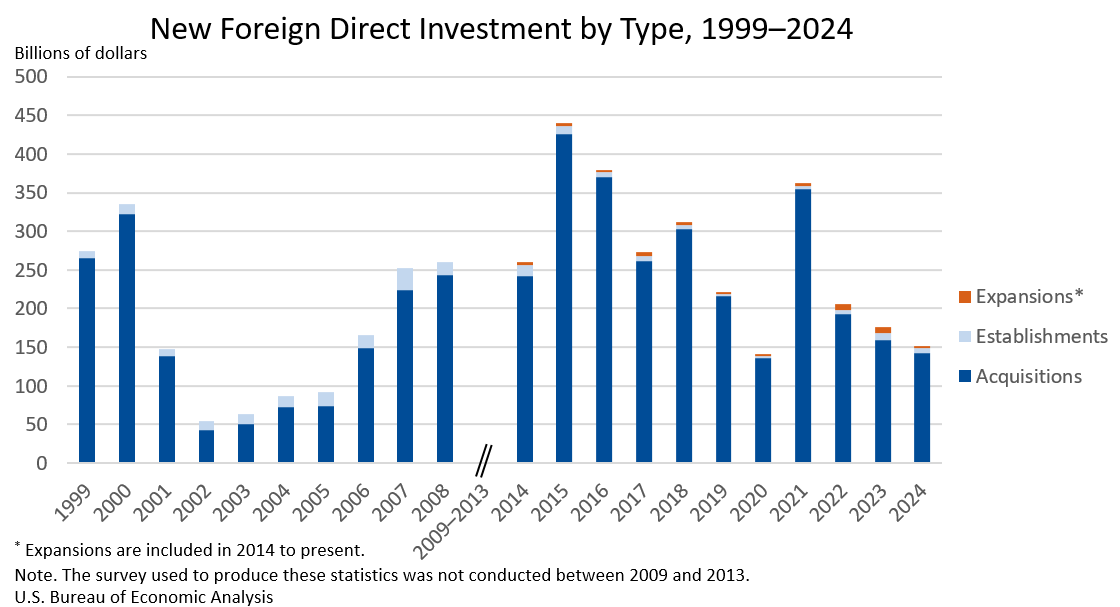Bureau of Economic Analysis
New Foreign Direct Investment in the United States, 2024
Expenditures by foreign direct investors to acquire, establish, or expand U.S. businesses totaled $151.0 billion in 2024, according to preliminary statistics released today by the U.S. Bureau of Economic Analysis. Expenditures decreased $24.9 billion, or 14.2 percent, from $176.0 billion (revised) in 2023 and were below the annual average of $277.2 billion for 2014–2023. As in previous years, acquisitions of existing U.S. businesses accounted for most of the expenditures.
Principal Federal Economic Indicators
Noteworthy
- 2025 News Release Schedule
- Innovation at BEA
- 2025 Annual Updates
- New! Services Trade Data for More Countries
- Data Tool: Trade in Value Added
- Distribution of State Personal Income
- Updated: RIMS II Regional Multipliers
- Arts and Culture
- Space Economy
- FDI Now in State BEARFACTS
- Quick Guide: Price Indexes
The Latest
Personal Income and Outlays, January 2023
Personal income increased $131.1 billion, or 0.6 percent at a monthly rate, while consumer spending increased $312.5 billion, or 1.8 percent, in January. The increase in personal income primarily reflected an increase in compensation. Government social benefits decreased in January, reflecting a decrease in “other” benefits that was partly offset by an increase in Social Security. The personal saving rate (that is, personal saving as a…
Personal Income and Outlays, January 2023
Personal income increased $131.1 billion, or 0.6 percent at a monthly rate, while consumer spending increased $312.5 billion, or 1.8 percent, in January. The increase in personal income primarily reflected an increase in compensation. Government social benefits decreased in January, reflecting a decrease in “other” benefits that was partly offset by an increase in Social Security. The personal saving rate (that is, personal saving as a…
Gross Domestic Product, Fourth Quarter 2022 and Year 2022
Real gross domestic product (GDP) increased at an annual rate of 2.7 percent in the fourth quarter of 2022, after increasing 3.2 percent in the third quarter. The increase in the fourth quarter primarily reflected increases in inventory investment and consumer spending that were partly offset by a decrease in housing investment.
Gross Domestic Product, Fourth Quarter and Year 2022 (Second Estimate)
Real gross domestic product (GDP) increased at an annual rate of 2.7 percent in the fourth quarter of 2022, after increasing 3.2 percent in the third quarter. The increase in the fourth quarter primarily reflected increases in inventory investment and consumer spending that were partly offset by a decrease in housing investment.
Coming Soon: A Closer Look at the Mix of Global and Domestic Content in U.S. Exports
BEA is expanding its prototype statistics that provide a more complete and nuanced understanding of U.S. exports. Watch for an update and expansion of the statistics known as trade in value added, or TiVA, coming in March.
New Platform Helps Researchers Apply to Use BEA Microdata
Researchers interested in using BEA’s confidential microdata now have new resources for discovering the data and applying for access for their research projects.
The Bureau of Economic Analysis and other federal statistical agencies worked together to create a standard application process for the agencies’ restricted-use data, including BEA’s confidential, company-specific international trade and investment data.
New Health Care Statistics for First Year of COVID-19 Pandemic
The Bureau of Economic Analysis today released estimates for 2020 that measure health care spending by medical condition. In the first year of the COVID-19 pandemic, spending on infectious and parasitic diseases amounted to more than $222 billion, growing $83.3 billion over 2019, according to the statistics in BEA’s Health Care Satellite Account.
2022 Trade Gap is $948.1 Billion
The U.S. international trade deficit increased in 2022 according to the U.S. Bureau of Economic Analysis and the U.S. Census Bureau. The deficit increased from $845.0 billion in 2021 to $948.1 billion in 2022, as imports increased more than exports. The goods deficit increased $101.5 billion in 2022 to $1,191.8 billion. The services surplus decreased $1.6 billion in 2022 to $243.7 billion. The goods and services deficit was 3.7 percent of…
December 2022 Trade Gap is $67.4 Billion
The U.S. monthly international trade deficit increased in December 2022 according to the U.S. Bureau of Economic Analysis and the U.S. Census Bureau. The deficit increased from $61.0 billion in November (revised) to $67.4 billion in December, as imports increased and exports decreased. The goods deficit increased $7.4 billion in December to $90.6 billion. The services surplus increased $1.0 billion in December to $23.2 billion.
U.S. International Trade in Goods and Services, December and Annual 2022
The U.S. monthly international trade deficit increased in December 2022 according to the U.S. Bureau of Economic Analysis and the U.S. Census Bureau. The deficit increased from $61.0 billion in November (revised) to $67.4 billion in December, as imports increased and exports decreased. The goods deficit increased $7.4 billion in December to $90.6 billion. The services surplus increased $1.0 billion in December to $23.2 billion.




